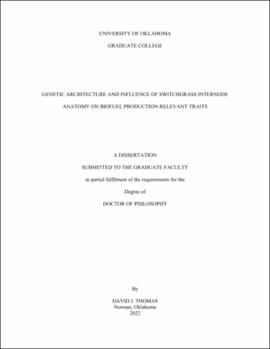| dc.description.abstract | Biofuels produced from plant biomass, such as switchgrass, have the potential to mitigate the increasing pace of rising atmospheric CO2 and global temperatures caused in part by the burning of fossil fuels. Biofuels produced from photosynthetically sequestered carbon in plant cell walls represent a contemporary capture-and-release cycle of carbon, compared to the net increase of carbon released into the atmosphere when burning fossil fuels. The main needs of biomass improvement for biofuels to become a viable alternative to fossil fuels are to (1) increase biomass yield and (2), improve biomass composition to increase biomass deconstruction efficiency. The anatomy of switchgrass tiller internodes remains intact even after standard mechanical deconstruction of biomass prior to chemical deconstruction. However, the impact of internode anatomy on biomass deconstruction efficiency is poorly understood. Furthermore, current understanding of internode anatomy plasticity in genotype clones caused by varied conditions across environments in this context is also lacking. Therefore, our goal is to explore the influence of internode anatomy variation on biofuel-relevant traits in switchgrass biomass and to increase our understanding of genetic control of internode anatomy variation.
This research analyzed internode anatomy of lowest above ground internodes in clones of upland (VS16, DAC) and lowland (AP13, WBC) switchgrass genotypes at three common garden sites in: South Texas, Central Missouri, and Central Michigan. Cortical cell wall thickness (CWT) varies independently of 21 other traits measured and suggests unique genetic control may be present for optimization. Cortical cell wall thickness also negatively correlates with digestion efficiency and mild resistance to loss of hydraulic conductivity. Next, we narrowed our focus to establish a genetic basis of internode anatomy variation with quantitative trait loci (QTL) analysis in the F2 progeny of a four-way outbred mapping population grown at a single site. Anatomical measurements of the F2 mapping population were utilized in QTL analysis to identify eight QTLs for six internode anatomy traits including cortical cell wall thickness, cortex radius, chlorenchyma radius, annulus area, epidermis cell count, and cortex-to-rind ratio. Candidate genes involved in various processes from cell cycle and hormone regulation to cell wall biosynthesis are present in the QTL intervals. Next we found that all biomass composition traits of lowland WBC vary significantly in clones grown across ten environments and 17 degrees of latitude. Lastly, we provide a detailed description of our hand sectioning method and present a 3D-printed microtome, “The Rapid-Tome”, specifically designed to effectively section hollow and tough materials such as switchgrass and woody stems up to 8 mm thick.
In total, this dissertation provides a valuable morphometric analysis of switchgrass internode anatomy and supports the long-term goal of enhancing biomass for biofuel production. This work identified variable internode anatomy traits that impact biomass digestibility and provide evidence that internode anatomy is an important factor of biomass tissue characteristics. This work shows that internode anatomy variation across environments shows potential to match genotype to specific environments to optimize internode anatomy for biomass conversion efficiency into biofuels. Furthermore, the QTL and candidate genes identified provide guidance for selectively breeding favorable internode anatomy phenotypes and presents a genetic basis for future genetic engineering of biofuel production-relevant traits. | en_US |

